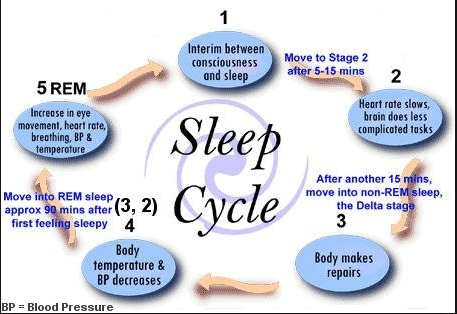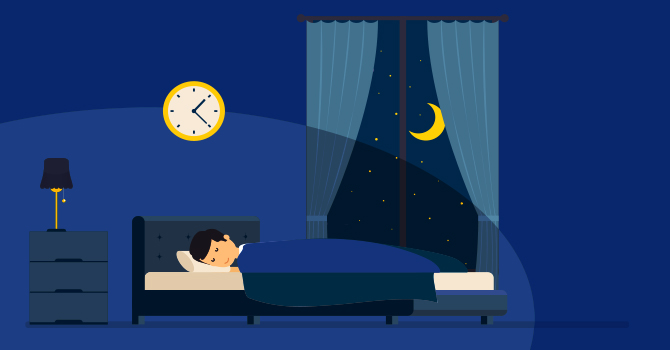Stages of sleep:

Image to the right: has approximate times for each stage of sleep. Keep in mind that everyone’s sleep stages vary!
Sleep is split into stages throughout the night; there is nREM (non Rapid Eye Movement) which is in four stages and then the REM (Rapid Eye Movement) sleep stage. REM stage of sleep is important for memory consolidation. The stages of nREM are also important for memory consolidation, but also for many other bodily functions.
Stage 1 of nREM: This phase is considered the change from being fully awake to sleeping and only lasts 1 to 7 minutes. Since it’s a very short phase, the main purpose of it is to prepare you for the rest of the sleep stages. Everything slows down, however this stage is easily interrupted if there is too much noise. Since this stage can be disrupted, sometimes you can jerk back awake.
Stage 2 of nREM: This stage of sleep lasts approximately 10 to 25 minutes in the initial cycle and lengthens with each cycle after that. By the end of the night, this stage should constitute between 45 to 55 percent of the total sleep. Someone in stage 2 of sleep requires more intense stimuli than in stage 1 to awaken. In this stage, your heart rate and breathing begin to really slow down. You can see this phase in the brain because the actual wave activity slows down with only a short burst throughout.
Stages 3 and 4 of nREM: These two stages of sleep are referred to as slow-wave sleep. This is called deep sleep, everything is at its slowest and you become very challenging to wake. Stage 3 lasts only a few minutes and constitutes about 3 to 8 percent of sleep. Stage 4 lasts about 20 to 40 minutes in the first cycle and makes up about 10 to 15 percent of total sleep.
REM Stage: During the first cycle of sleep, the REM period lasts only 1 to 5 minutes; however, it becomes more prolonged as the sleep cycles progress. This stage of sleep is the final phase of sleep, where the brain comes to life. This is the phase where dreams occur with all of the brain activity; there is presence of desynchronized (low-voltage, mixed-frequency) brain wave activity, muscle atonia, and bursts of rapid eye movements. The brain begins to function similar to an awake brain, and breathing/heart rate return to waking levels. During this phase many motor muscles are paralyzed. REM cycles start about 90 minutes after stage 1 of sleep.
It is important to get good amounts of both REM and nREM sleep to consolidate memories as well as for overall health in individuals.
Sources:
Institute of Medicine (US) Committee on Sleep Medicine and Research; Colten HR, Altevogt BM, editors. Sleep Disorders and Sleep Deprivation: An Unmet Public Health Problem. Washington (DC): National Academies Press (US); 2006. 2, Sleep Physiology. Available from: https://www.ncbi.nlm.nih.gov/books/NBK19956/
